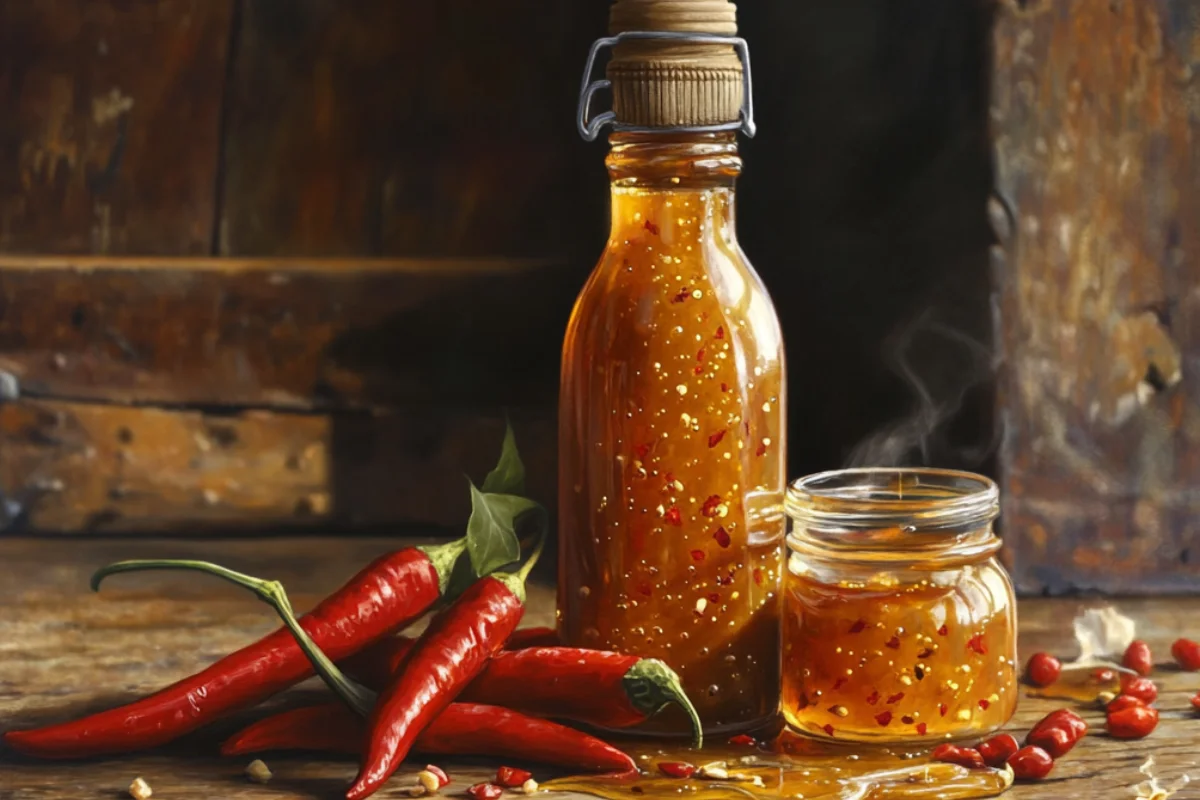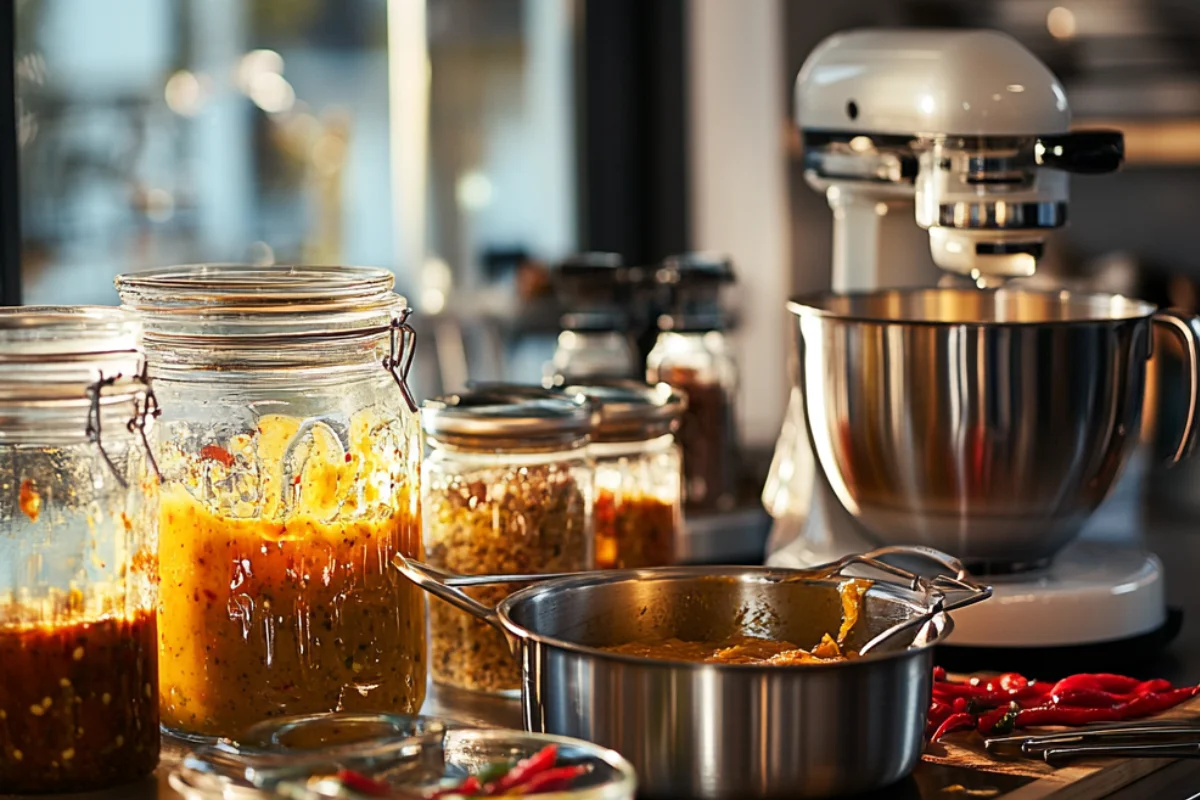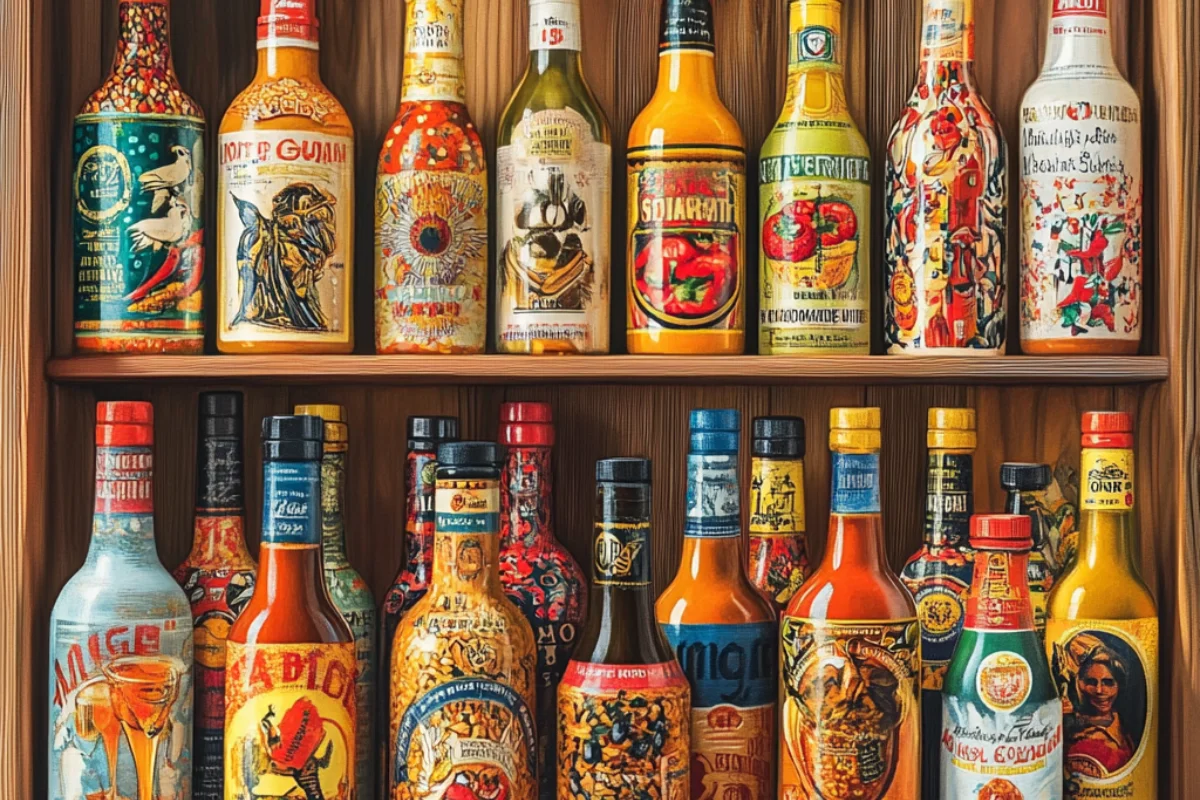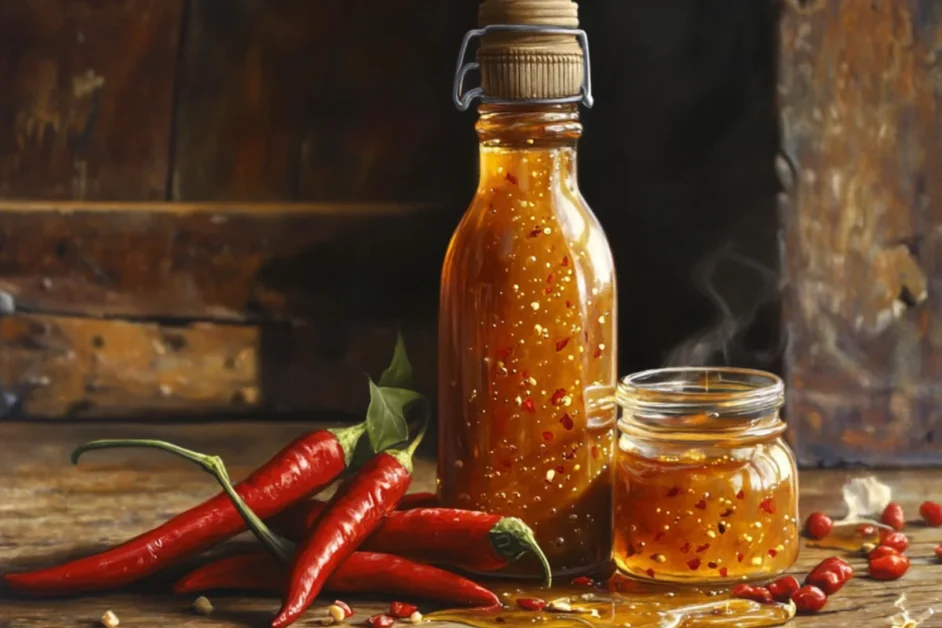Introduction:

Honey hot sauce has become a culinary favorite, blending the natural sweetness of honey with the fiery heat of chili peppers. This dynamic combination has captured the hearts of food enthusiasts, chefs, and home cooks alike. But what exactly makes this condiment so popular? From its historical roots to its increasing role in modern food trends, honey hot sauce offers a perfect balance of sweet and spicy flavors that enhances countless dishes. Let’s dive into its origins, ingredients, and the reasons behind its rising fame.
The Basics of Honey Hot Sauce
Honey hot sauce is a versatile condiment that combines honey, chili peppers, and other ingredients to create a sauce with both sweet and spicy notes. Its primary purpose is to elevate dishes by adding depth of flavor and a touch of heat. Here’s what makes it special:
- Versatile Uses: Honey hot sauce is a perfect pairing for chicken wings, roasted vegetables, seafood, pizza, and even desserts like ice cream.
- Sweet Meets Heat: The natural sweetness of honey balances the fiery kick of hot peppers, making it an excellent choice for those who enjoy complex flavor profiles.
- DIY Possibilities: Home cooks can easily customize honey hot sauce to their liking by adjusting the spice level, type of honey, or adding unique ingredients like garlic or smoked paprika.
This balance between sweetness and heat makes honey hot sauce a favorite in kitchens worldwide.
A Brief History of Honey-Based Sauces
Honey has been a staple in cooking for centuries, valued not only for its sweetness but also for its preservative qualities. Its use in condiments dates back to ancient civilizations:
- Ancient Egypt: Honey was used to create sweet marinades and sauces for meats.
- Medieval Europe: Honey-based sauces were combined with vinegar and spices to preserve food and enhance flavor.
- Caribbean Influence: In tropical regions, honey was often paired with fiery chili peppers, laying the groundwork for today’s honey hot sauce.
The evolution of honey-based sauces demonstrates how cultures across the globe have long recognized the magic of pairing sweetness with spice.
Why Honey and Hot Sauce Work Together
The success of honey hot sauce lies in its flavor profile. The combination of sweet and spicy triggers a dynamic sensory experience:
- Contrast and Balance: Honey’s sweetness tempers the heat of chili peppers, creating a harmonious blend of flavors.
- Enhanced Depth: Adding honey to hot sauce provides a rich, caramelized undertone that intensifies the overall flavor.
- Versatility in Cuisine: This sweet-and-spicy combo complements a wide range of foods, from savory meats to desserts.
Whether drizzled on crispy fried chicken or swirled into creamy dips, honey hot sauce enhances dishes with its bold yet balanced taste.
Common Variations Across Regions
Honey hot sauce recipes vary significantly across cultures and cuisines. Here’s a glimpse into how different regions put their own spin on this beloved condiment:
- American: Classic recipes often combine honey with cayenne or habanero peppers for a sweet yet bold kick. Think Buffalo honey wings or barbecue-glazed ribs.
- Asian: Asian variations may include ingredients like soy sauce, ginger, or sesame oil, resulting in a sweet, spicy, and umami-packed sauce perfect for stir-fries and dumplings.
- Caribbean: Caribbean honey hot sauce often incorporates scotch bonnet peppers, allspice, and citrus, delivering an intense tropical heat with sweet undertones.
- Middle Eastern: Middle Eastern-inspired versions may include tahini or sumac for a nutty or tangy dimension.
Each regional twist adds unique flavors, showcasing the versatility of honey hot sauce in different culinary traditions.
Popular Uses in Dishes
Honey hot sauce shines in a variety of dishes, making it a must-have in any kitchen. Some of the most popular uses include:
- Chicken Wings: Toss crispy wings in honey hot sauce for a sweet and spicy glaze.
- Pizza: Drizzle it over pepperoni pizza or add it to a Margherita for a surprising kick.
- Seafood: Use it as a dip for shrimp or a glaze for grilled salmon.
- Vegetables: Roast carrots, sweet potatoes, or Brussels sprouts with a honey hot sauce drizzle for extra flavor.
- Sandwiches: Spread it on fried chicken sandwiches or burgers to elevate their taste.
- Desserts: Yes, honey hot sauce works in desserts! Try it on vanilla ice cream or drizzled over a honey cake for a bold finish.
Its ability to complement both savory and sweet dishes makes honey hot sauce a versatile and indispensable condiment.
The Rise of Honey Hot Sauce in Food Trends
In recent years, honey hot sauce has seen a surge in popularity, becoming a staple in trendy restaurants and home kitchens. Reasons for its rise include:
- Influence of Social Media: Platforms like Instagram and TikTok have showcased creative uses for honey hot sauce, from pizza drizzles to dessert pairings.
- Health Consciousness: With honey as a natural sweetener, it appeals to those seeking cleaner ingredient options.
- Fusion Cuisine: The global trend of combining flavors from different cultures has brought honey hot sauce into the spotlight.
- Versatility: Its ability to enhance virtually any dish makes it a favorite for both chefs and home cooks.
As food trends continue to evolve, honey hot sauce remains at the forefront of culinary innovation.
Essential Ingredients in Honey Hot Sauce
At its core, honey hot sauce requires just a few key ingredients:
- Honey: Provides sweetness and richness.
- Chili Peppers: Adds heat and flavor complexity.
- Vinegar: Balances the sweetness with acidity.
- Salt and Spices: Enhances the overall flavor profile.
- Optional Add-Ins: Garlic, ginger, or smoked paprika for additional depth.
These ingredients come together to create a sauce that’s simple yet deeply satisfying.
Importance of Quality Honey
Not all honey is created equal, and the type you use can greatly affect the flavor of your honey hot sauce. Here’s why:
- Raw Honey: Retains its natural nutrients and complex flavors, making it the best choice for sauces.
- Organic Honey: Free from additives, ensuring a pure and authentic taste.
- Regional Honey: Local varieties may have unique floral notes that add depth to your sauce.
Using high-quality honey ensures a richer and more balanced flavor, elevating your honey hot sauce to the next level.
Selecting the Right Peppers for Spice
The choice of chili peppers is crucial in determining the heat level and flavor of honey hot sauce. Here are some popular options:
- Mild Peppers: Jalapeños or Anaheim peppers offer a subtle heat, perfect for those who prefer a gentler spice.
- Medium Heat: Serrano or cayenne peppers add a bold kick without overwhelming the palate.
- Extreme Heat: Habaneros, ghost peppers, or Carolina Reapers bring intense spiciness for heat lovers.
By experimenting with different peppers, you can customize the spice level and flavor profile to suit your taste.
The Role of Vinegar and Acidic Components
Vinegar plays a critical role in honey hot sauce, balancing its sweetness and enhancing its depth of flavor. Common types of vinegar used include:
- Apple Cider Vinegar: Adds a tangy, fruity note.
- White Vinegar: Provides a sharp and clean acidity.
- Rice Vinegar: Brings a mild, slightly sweet flavor.
Acidic components like vinegar not only balance the flavors but also act as a natural preservative, ensuring your honey hot sauce stays fresh longer.
Making Honey Hot Sauce at Home: A Complete Guide

Creating your own honey hot sauce at home is not only fun but also allows you to customize the flavor and spice to suit your preferences. Whether you want a simple recipe or a sauce with bold, infused flavors, this guide will walk you through every step, from preparation to storage. Let’s dive into the equipment you’ll need, the recipe, and pro tips for achieving that perfect sweet and spicy balance.
1. Equipment Needed for Homemade Honey Hot Sauce
Before you start, ensure you have the following tools for a smooth cooking process:
- Saucepan: For simmering the ingredients.
- Blender or Food Processor: To puree the sauce into a smooth consistency.
- Fine Mesh Sieve: For straining seeds or pulp, ensuring a silky texture.
- Measuring Cups and Spoons: For precise ingredient ratios.
- Glass Storage Jars or Bottles: Airtight containers to store your finished sauce.
- Rubber Spatula: To scrape down the sides of the blender or saucepan.
Having the right tools ensures your homemade honey hot sauce is easy to make and perfectly textured.
2. Basic Honey Hot Sauce Recipe
Here’s a simple yet delicious recipe that uses minimal ingredients:
Ingredients:
- 1 cup honey
- 2-3 chili peppers (e.g., jalapeño, habanero, or cayenne)
- 1/4 cup apple cider vinegar
- 1/4 cup water
- 1/2 teaspoon salt
Instructions:
- Prepare the Peppers: Remove stems and seeds for less heat, or leave them in for extra spice.
- Simmer Ingredients: In a saucepan, combine the honey, chili peppers, vinegar, water, and salt. Simmer on low heat for 10 minutes.
- Blend: Pour the mixture into a blender and blend until smooth.
- Strain: Use a sieve to remove any seeds or pulp for a silky finish.
- Cool and Store: Let the sauce cool completely before transferring it to an airtight jar.
This recipe serves as a base that you can adjust and customize to suit your taste.
3. Customizing Your Heat Level
The spice intensity of honey hot sauce depends on the type and quantity of chili peppers used. Here’s how to adjust the heat:
- Mild Heat: Use fewer peppers or opt for mild varieties like Anaheim or poblano.
- Medium Heat: Add serrano or cayenne peppers for a moderate kick.
- High Heat: Incorporate habaneros or ghost peppers for a fiery result.
- Blending Spices: Add a pinch of smoked paprika or cayenne powder to enhance the heat without increasing peppers.
Customizing your sauce allows you to strike the perfect balance between sweetness and spice.
4. Infusing Additional Flavors
Take your honey hot sauce to the next level by experimenting with these infused flavors:
- Garlic: Add minced garlic while simmering for a savory twist.
- Ginger: Include fresh ginger slices for a warm, zesty kick.
- Citrus: Squeeze in lime or orange juice for a tangy and bright flavor.
- Herbs: Fresh thyme or rosemary can add an earthy depth to your sauce.
- Smokiness: Use smoked chili peppers or liquid smoke for a BBQ-inspired flavor.
Infusions make your sauce more unique and tailored to your taste.
5. Tips for Achieving Perfect Consistency
Consistency can make or break a sauce. To ensure your honey hot sauce has the perfect pourable texture:
- Control the Liquid: Start with a small amount of water and gradually add more if needed.
- Simmer Time: Longer simmering reduces water content, thickening the sauce.
- Blend Thoroughly: A high-speed blender creates a smoother texture.
- Strain the Sauce: Use a fine mesh sieve to remove any seeds or solid bits.
For a thicker sauce, reduce the liquid; for a thinner sauce, add water in small increments.
6. Preserving and Storing Your Sauce
Proper storage ensures your honey hot sauce stays fresh and safe to eat:
- Refrigeration: Store the sauce in an airtight jar in the fridge for up to 3 months.
- Freezing: Freeze in small portions for up to 6 months for extended shelf life.
- Sterilized Jars: Use sterilized jars for longer storage, particularly if you plan to gift the sauce.
- Avoid Contamination: Use clean spoons when serving to prevent introducing bacteria.
By following these tips, you can enjoy your homemade sauce for weeks or even months.
7. Using Honey Substitutes or Alternatives
If honey isn’t your preferred sweetener, here are some alternatives that work just as well:
- Maple Syrup: Adds a rich, earthy sweetness.
- Agave Nectar: A vegan-friendly option with a mild flavor.
- Coconut Syrup: Provides a tropical note to the sauce.
- Brown Sugar: Creates a deep, molasses-like flavor.
These substitutes allow for experimentation while catering to dietary needs.
8. Vegan and Gluten-Free Honey Hot Sauce Options
To make a vegan or gluten-free honey hot sauce:
- Honey Replacement: Use agave nectar or maple syrup instead of honey.
- Gluten-Free Vinegar: Opt for distilled white vinegar or apple cider vinegar labeled gluten-free.
- Natural Spices: Avoid spice blends that may contain gluten additives.
These adjustments ensure your sauce is inclusive for various dietary preferences.
9. Troubleshooting Common Issues
Homemade sauces can sometimes pose challenges. Here’s how to troubleshoot:
- Separation: Blend the sauce longer or add a small amount of xanthan gum to stabilize it.
- Too Spicy: Add more honey or vinegar to dilute the heat.
- Too Sweet: Increase the quantity of chili peppers or add a pinch of salt.
- Thick or Thin Sauce: Adjust with water or simmer longer to reach the desired consistency.
Troubleshooting ensures your honey hot sauce turns out just right every time.
10. Batch Scaling for Large Quantities
If you’re making honey hot sauce for a party or event, scaling the recipe is straightforward:
- Double or Triple Ingredients: Maintain the same ratio of honey, peppers, vinegar, and water.
- Use a Large Pot: To accommodate larger quantities without spilling.
- Longer Simmer Time: Larger batches may require additional time for flavors to meld.
- Storage: Divide into multiple jars for easier use and storage.
With these tips, you can prepare a large batch without compromising on quality.
Exploring Store-Bought and Specialty Honey Hot Sauces
While making your own honey hot sauce at home can be a rewarding experience, the market is brimming with diverse and exciting options for those looking to explore commercially available varieties. From top-rated brands to regional specialties, honey hot sauces have earned their place on supermarket shelves and gourmet stores worldwide. This guide dives into the best store-bought options, how to spot high-quality products, and creative ways to use honey hot sauce in your daily meals and beyond.
1. Top Brands of Honey Hot Sauce

Several brands have perfected the art of balancing sweetness and heat. Here’s a look at some of the most popular options and their standout features:
- Mike’s Hot Honey: A fan-favorite, this sauce blends honey with chili peppers for a mild, well-balanced flavor perfect for drizzling on pizza or fried chicken.
- Yellowbird Blue Agave Sriracha: A unique twist, combining honey-like sweetness with a touch of agave and bold spices.
- Bee Sting Honey N’ Habanero: Known for its tropical flavor, this sauce combines the fruity heat of habanero peppers with rich honey notes.
- Nando’s Peri-Peri Hot Honey Sauce: Infused with African bird’s eye chilies, this offers a zesty and slightly smoky profile.
These brands offer versatility, allowing you to explore honey hot sauce in different dishes and cuisines.
2. Regional Specialty Honey Hot Sauces
Around the world, honey hot sauces take on regional characteristics influenced by local ingredients and culinary traditions:
- American South: Many Southern-style honey hot sauces feature cayenne and smoked paprika, making them a staple for BBQ and fried chicken.
- Caribbean: Scotch bonnet peppers and tropical fruits like mango or pineapple are often added for a vibrant, sweet, and spicy taste.
- Asian Varieties: These sauces may include soy sauce, ginger, and sesame for a bold umami flavor, often used in stir-fries or as a dipping sauce.
- Mediterranean: Honey hot sauces from this region might feature thyme or rosemary for a herbaceous undertone.
Regional specialties showcase the incredible versatility of honey hot sauce, adapting beautifully to different cuisines.
3. Organic and All-Natural Store-Bought Options
For those prioritizing health and sustainability, several brands offer organic and all-natural honey hot sauces. These options are free from artificial preservatives, colors, and high-fructose corn syrup:
- Nature Nate’s Honey Infusions: Combines raw, unfiltered honey with organic peppers for a clean, preservative-free option.
- Runamok Sparkle Syrup: A fun twist, this honey-based hot sauce includes edible glitter alongside all-natural ingredients.
- Trader Joe’s Organic Spicy Honey Sauce: Affordable and free from artificial additives, this is a go-to for many health-conscious shoppers.
Choosing organic or natural sauces ensures you get maximum flavor without compromising on quality.
4. Comparing Homemade vs. Store-Bought Sauces
While both options have their merits, here’s a quick breakdown of the pros and cons of homemade versus store-bought honey hot sauces:
Homemade Sauces:
- Pros: Fully customizable, free from preservatives, cost-effective for large batches.
- Cons: Requires time, effort, and proper storage for freshness.
Store-Bought Sauces:
- Pros: Convenient, long shelf life, consistent flavor.
- Cons: May contain additives or lack the personalization of homemade varieties.
Ultimately, the choice depends on your priorities—whether it’s convenience or the joy of creating your own unique sauce.
5. Pairing Honey Hot Sauce with Drinks
The sweet and spicy profile of honey hot sauce opens up exciting opportunities for drink pairings. Here are some options:
- Cocktails:
- Spicy Margaritas: Use honey hot sauce as a rim dip or mix it with lime juice and tequila.
- Honey Bourbon Smash: A blend of bourbon, honey, and a dash of hot sauce creates a warming yet refreshing drink.
- Beers:
- Pair it with a crisp lager or IPA to balance the heat and sweetness.
- Mocktails:
- Mix honey hot sauce with ginger ale, lime, and a splash of soda for a non-alcoholic spicy kick.
Adding honey hot sauce to drinks creates a surprising yet delightful twist.
6. Creative Packaging Ideas for Gifts
Homemade honey hot sauce makes a thoughtful and delicious gift. Elevate your packaging with these creative ideas:
- Glass Bottles with Labels: Use vintage-style bottles and personalized labels to give your sauce a professional touch.
- Gift Baskets: Pair your sauce with complementary items like gourmet crackers, cheese, or infused oils.
- Miniature Bottles: Perfect for party favors or sampling different flavor varieties.
- Seasonal Themes: Add festive ribbons or tags for holidays, weddings, or birthdays.
With thoughtful packaging, your homemade honey hot sauce becomes a memorable gift.
7. How to Spot High-Quality Commercial Products
To ensure you’re purchasing a top-notch honey hot sauce, consider the following tips:
- Read the Ingredients: Look for real honey and natural chili peppers; avoid artificial sweeteners or additives.
- Check the Label: Organic certifications and “all-natural” claims often indicate higher-quality products.
- Taste Test: Many gourmet stores offer samples, allowing you to try before buying.
- Reviews and Ratings: Customer feedback can provide insight into flavor and quality.
Investing in a quality product ensures a better experience and more robust flavors.
8. Pairing with Different Types of Cuisine
Honey hot sauce is a versatile condiment that pairs beautifully with global cuisines:
- BBQ: Use it as a glaze for ribs or a dipping sauce for smoked meats.
- Mexican: Drizzle it over tacos, enchiladas, or quesadillas for a sweet-spicy twist.
- Korean: Add it to fried chicken or bibimbap for a fusion of flavors.
- Italian: Try it on pepperoni pizza or mixed into marinara for an unexpected kick.
Its ability to complement various cuisines makes it a kitchen essential.
9. Incorporating Honey Hot Sauce in Desserts
Surprisingly, honey hot sauce can add depth and intrigue to sweet dishes. Try these ideas:
- Ice Cream: Drizzle it over vanilla or salted caramel ice cream for a sweet-heat combo.
- Brownies: Swirl honey hot sauce into the batter before baking for a subtle spice.
- Honey Cakes: Brush it on warm honey cake as a glaze for added complexity.
- Fruit Salads: A light drizzle over tropical fruits like mango or pineapple enhances their natural sweetness.
Its sweet-spicy profile works wonders in both savory and dessert applications.
10. Honey Hot Sauce in Health and Wellness
Both honey and chili peppers boast potential health benefits, making honey hot sauce a tasty and functional addition to your diet:
- Honey:
- Rich in antioxidants, which help combat inflammation.
- Known for its soothing effects on sore throats and coughs.
- Chili Peppers:
- Contain capsaicin, which can boost metabolism and promote heart health.
- May help reduce inflammation and support pain relief.
While honey hot sauce should be enjoyed in moderation, its ingredients can contribute to a balanced and health-conscious lifestyle.
FAQs About Honey Hot Sauce
Here are some frequently asked questions about honey hot sauce, covering everything from recipes to storage and uses:
1. What is honey hot sauce made of?
Honey hot sauce typically combines honey, chili peppers, vinegar, and salt. Additional ingredients like garlic, ginger, or citrus can be added for unique flavor twists.
2. How spicy is honey hot sauce?
The spice level depends on the type and quantity of chili peppers used. It can range from mild (using jalapeños) to extremely spicy (using habaneros or ghost peppers).
3. Can I make honey hot sauce without chili peppers?
Yes! You can use cayenne powder, red pepper flakes, or even hot sauce as a substitute for fresh chili peppers if needed.
4. How long does homemade honey hot sauce last?
When stored in an airtight container in the fridge, homemade honey hot sauce can last up to 3 months. Always use clean utensils to avoid contamination.
5. Can I use honey hot sauce in desserts?
Absolutely! Drizzle it on ice cream, swirl it into brownies, or glaze a honey cake for a unique sweet-and-spicy dessert experience.
6. Are there vegan alternatives for honey hot sauce?
Yes, you can substitute honey with vegan options like agave nectar, maple syrup, or coconut syrup to create a plant based version.
7. Is honey hot sauce gluten-free?
Most honey hot sauces are naturally gluten free, but it’s essential to check labels for potential cross-contamination or gluten containing additives.
8. What foods pair best with honey hot sauce?
Honey hot sauce pairs well with chicken wings, pizza, roasted vegetables, tacos, BBQ ribs, seafood, and even cocktails or mocktails.
9. Can I adjust the thickness of honey hot sauce?
Yes, you can control the consistency by adjusting the water content. For a thicker sauce, simmer longer to reduce the liquid. For a thinner sauce, add water in small increments.
10. Are there health benefits to honey hot sauce?
Yes! Honey provides antioxidants and natural sweetness, while chili peppers contain capsaicin, which may boost metabolism and reduce inflammation. Together, they make a flavorful and potentially beneficial condiment.

